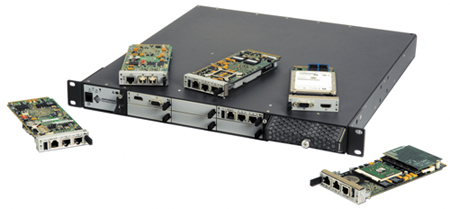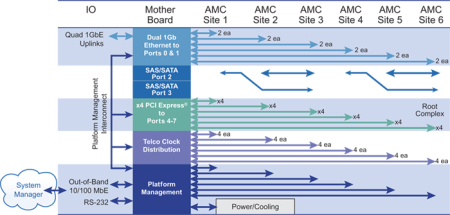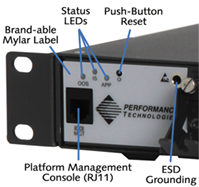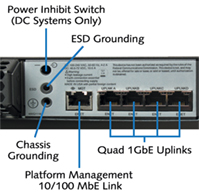Six-slot MicroTCA system runs Carrier Grade Linux
Mar 18, 2009 — by Eric Brown — from the LinuxDevices Archive — 19 views Performance Technologies (PT) is shipping a 1U MicroTCA system aimed at telecom, networking, and aero/defense communication systems. The AMP5071 offers Intel Core 2 Duo or Freescale MPC8641D dual-core processors, up to six AMC modules, dual gigabit Ethernet ports, and PT's CGL-compliant NexusWare Linux distribution.
Performance Technologies (PT) is shipping a 1U MicroTCA system aimed at telecom, networking, and aero/defense communication systems. The AMP5071 offers Intel Core 2 Duo or Freescale MPC8641D dual-core processors, up to six AMC modules, dual gigabit Ethernet ports, and PT's CGL-compliant NexusWare Linux distribution.
(Click for larger view of the AMP5071)
The IPnexus-family AMP5071 is designed for system engineers developing IP-based communication products. Target applications include WiMAX gateways, LTE infrastructure equipment, radar gateways, weather alert systems, enterprise VoIP/SIP servers, transportation network equipment, and scientific compute and monitoring systems, says PT.
Like the similar, Core 2 Duo-ready AMP5070 announced last May, the AMP5071 adheres to the PICMG's MicroTCA specification, which is aimed at extending the reliability benefits of carrier-grade telecom systems to lower-cost device markets. Both AMP507x models are based on the MTC5070, PT's first MicroTCA chassis, which was announced in April 2008.

MTC5070 chassis with some available AMC modules
The MTC5070 chassis boasts a 1U rack-mount design claimed to have an “innovative” push/pull fan system. The chassis incorporates commodity PC power supplies instead of the pricey 48-volt DC power rails typical of traditional telecom equipment.
The “fully integrated” AMP5071 system can be bought preconfigured with the customer's choice of a variety of Advanced Mezzanine Card (AMC) modules, says the network equipment provider (NEP). One slot is taken up by a compute module for an Intel Core 2 Duo or Freescale MPC8641D dual-core processor. The Core 2 Duo module, called the AMC121, features the 64-bit dual-core chip clocked to 1.5GHz, with 4MB shared L2 cache and 4GB DDR2 with ECC. The alternative AMC131 processor module is equipped with the PowerPC-architecture Freescale MPC8641D dual-core processor clocked to 1GHz. The module is said to offer 1MB L2 cache, 2GB of DRAM, and 128MB of boot flash.
Additional AMC modules for I/O, storage, and compute functions can be integrated into the system, including up to four storage modules, such as PT's AMC590 video storage module. Communications options said to be available from PT include an AMC335 synchronous four-port WAN communications module, and the AMC304/305 quad-T1/E1/J1 communication controller modules. The slot bay supports all major AdvancedMC (AMC) form factors, including mid-size or full-size, or single or double modules, says the company.

The AMP5071's AMC interconnects
(Click to enlarge)
The AMP5071's Ethernet subsystem provides dual front-facing gigabit Ethernet ports, and it offers four RJ45 gigabit Ethernet uplinks on the rear panel in place of the AMP5070's dual uplinks, says PT. The system also supplies x4 PCI Express lanes to each AMC slot. It offers a front-facing serial console, but appears to lack the AMC5070's USB port. The AMP5071 is touted for its “four-nines” availability, made possible by its redundant hot-swappable power supplies and fan trays, steel enclosure, and embedded components.


Front (left) and rear I/O detail
Specifications listed for the AMC5071 include:
- Dual-core AMC processor modules — Intel Core 2 Duo 1.5GHz (2MB L2/4GB DDR2) or Freescale MPC8641D 1GHz (1MB L2/2GB DRAM/128MB boot flash)
- AMC configuration:
- AMC.1 (ports 4-7) — x1, x2, or x4 PCI Express
- AMC.2 (ports 0-1) — dual gigabit Ethernet
- AMC.3 (port 2) — 1 x SATA/SAS port
- AMC.0 — IPMB-L management interface
- PICMG compliance — MicroTCA.0, AMC.0, AMC.1, AMC.2, AMC.3
- Networking - 2 x gigabit Ethernet ports, front-facing; 4 x gigabit Ethernet uplinks, rear-facing; 10/100 Ethernet out-of-band shelf manager port
- Serial — front-panel console port
- Other features — removable fan tray and power supply; front-panel LEDs and reset switch
- Power — 100 to 240V AC input, 50 to 60Hz, 4 to 2A; -40.5 to -60V DC input, 10 to 5A
- Dimensions — 17.4 x 18.5 x 1.75 inches (1U)
- Operating temperature — 41 to 104 deg. F (5 to 40 deg. C)
- MTBF — 201,585 hours per Bellcore SR-332 Issue 1; 99.994 percent availability (four-nines)
- Operating system — NexusWare CGL Linux and NexusWare Portal preinstalled
The AMC5071 is preinstalled with the company's NexusWare Carrier Grade Linux (CGL) distribution and development environment, and offers the NexusWare Portal remote systems management software. PT is unusual among NEPs in that it offers its own distribution, which like MontaVista and Wind River's CGL distros, is registered against the CGL 4.0 specification.
Based on the 2.6.20 Linux kernel, NexusWare also integrates software from the OpenHPI project, which aims to maintain an open source implementation of the Service Availability Forum (SAF) HPI (hardware platform interface) specification. NexusWare ships with PT's “NexusWare Studio” suite of Eclipse-based development tools.
Stated Tony Romero, senior product manager at PT, “Our integrated platforms of hardware and fully developed Linux software enable system integrators and OEMs to more rapidly and cost-effectively design, develop, and deploy their next generation, IP-based communication systems.”
Availability
The IPnexus AMP5071 is available now in OEM quantity pricing of $4,600, including preconfigured processor and storage AMC modules, says PT. The company will be demonstrating the MicroTCA system at the 2009 Embedded Systems Conference (ESC) Silicon Valley, in San Jose, Calif., from March 31-April 2 (booth 1630). In addition, PT will be hosting a MicroTCA webinar on March 18 at 2PM EST. Registration may be found here.
More information on the AMP5071 may be found here, and more on NexusWare may be found here.
This article was originally published on LinuxDevices.com and has been donated to the open source community by QuinStreet Inc. Please visit LinuxToday.com for up-to-date news and articles about Linux and open source.